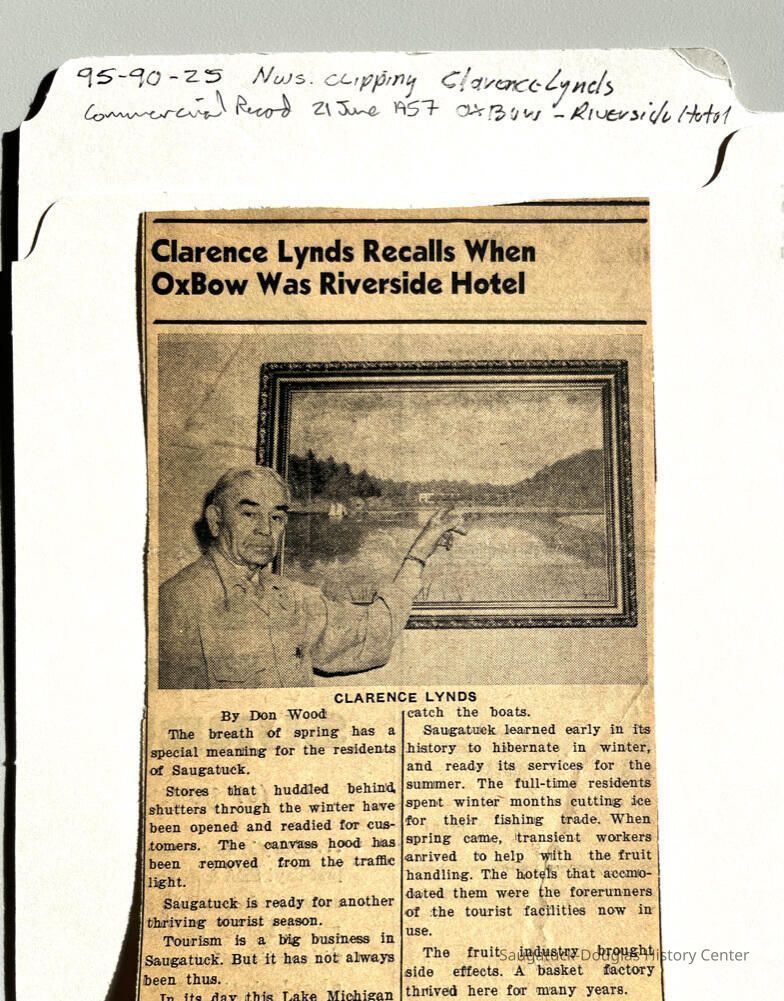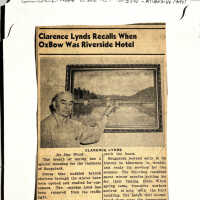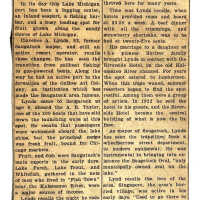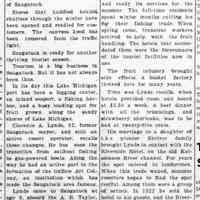Clarence Lynds article

2022.16.01
NewspapersArtworks
Winthers, Sally
Files Accession Number
Pier Cove 1839-
OCR scan of clipping By Don Wood The breath of spring has a special meaning for the residents of Saugatuck. Stores that huddled behind, shutters through the winter have been opened and readied for customers. The canvass hood has been removed from the traffic light. Saugatuck is ready for another thriving tourist season. Tourism is a big business in Saugatuck. But it has not always been thus. In its day this Lake Michigan port has been a logging center, an inland seaport, a fishing harbor, and a busy loading spot for fruit grown along the sandy shores of Lake Michigan. Clarence A. Lynd's, 82, former Saugatuck mayor, and still an active resort operator, recalls these changes. He has seen the transition from sailboat fishing to gas-powered boats. Along the way he had an active part in the formation of the OxBow Art Colony, an institution which has made the Saugatuck area famous. Lynds came to Saugatuck at age 9, aboard the A. B. Taylor, one Of the 200 boats that have slid down the launching ways at this spot. He recalls that passengers were welcomed) aboard the lake ships, but 'the principle cargo was fresh fruit, bound for Chicago markets. Fruit, and fish were Saugatuck’s main exports in the early days. Lake Perch, Lake Trout, and Whitefish, gathered in the nets of men who lived in “Fish Town” near the Kalamazoo River, were a major source of income. Lynds recalls the night he rode a steam tug outside the harbor in search of a sail-powered fishing boat which had been operated by his father-in-law, Charles Shriver. “We found the tiller, and the dog that was with him swam ashore,” Lynds said. The pioneer fisherman was never found. In the early 1900 era it was not unusual for a half dozen large lake freighters to load nightly Ln the Saugatuck area. Wagons hauled peaches, pears, apples, cherries to the docks, and latecomers raced their wagons 'to Pier Cove to catch the boats. Saugatuck learned early in its history to hibernate in winter, and ready its services for the summer. The full-time residents spent winter' months cutting ice for their fishing trade. When spring came, transient workers arrived to help with the fruit handling. The hotels that accommodated them were the forerunners of the tourist facilities now in use. The fruit industry brought side effects. A basket factory thrived here for many years. Time was Lynds recalls, when hotels provided room and board at $3.50 a week. A beef dinner with all the trimmings, and strawberry shortcake, was to be had at twenty-five cents. His marriage to a daughter of the pioneer Shriver family brought Lynds in contact with the Riverside Hotel, on the old Kalamazoo River channel. For years the spot catered to lumbermen. When this trade waned, summer resorters began to find the spot restful. Among them were a group of artists. In 1922 he sold the hotel to his guests, and the Riverside Hotel became the central building of what is now the Ox Bow. As mayor of Saugatuck, Lynds has seen the transition from a wheelbarrow street department, to modern equipment. He was instrumental in bringing into existence the Saugatuck Oval, “only municipally owned oval on the lake.” Lynds recalls the lore of the area. Singapore, the area’s hurried village, was active in his early days. “Used to go there to get sawdust 'for packing ice in the winter,” he says. The walls of his home on Griffith Street in Saugatuck are lined with paintings presented to him by his artist friends. Saugatuck has changed a lot in the Hast 8V years. From its beginning as a trading posit pioneered by William G. Butler, the town has survived the changes from lumber town, to shipping port, to fishing center, and is now one of the busiest spots in Allegan county in summer months.
02/25/2022
04/01/2024



